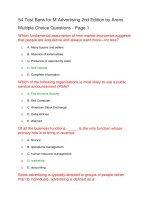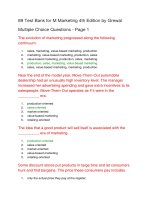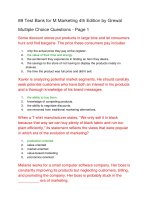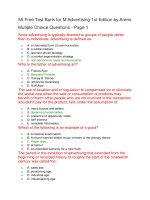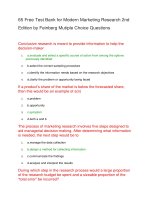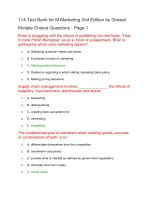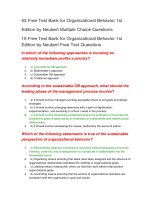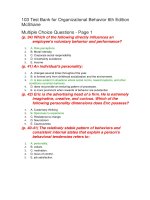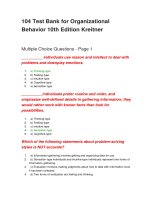109 test bank for m organizational behavior 2nd edition mcshane đề thi trắc nghiệm
Bạn đang xem bản rút gọn của tài liệu. Xem và tải ngay bản đầy đủ của tài liệu tại đây (133.59 KB, 25 trang )
109 Test Bank for M Organizational Behavior 2nd
Edition McShane
Multiple Choice Questions - Page 1
Which of the following refers to the path along which people
engage their effort towards achieving a goal?
1.
2.
3.
4.
5.
A. Persistence
B. Direction
C. Intensity
D. Aptitude
E. Competency
Which of the following models identifies the four factors that
directly influence individual behavior and
performance?
1.
2.
3.
4.
5.
A. Utilitarianism
B. The MARS model
C. Schwartz's model
D. Holland's model
E. The Myers-Briggs Type Indicator
_____ behaviors of employees transform raw materials into
goods and services or support and maintain the
technical activities.
1.
2.
3.
4.
5.
A. Maintenance
B. Organizational citizenship
C. Attentive
D. Motivational
E. Task performance
Organizational citizenship refers to:
1.
2.
3.
4.
A. an employee's right to vote in meetings.
B. employee behaviors that extend beyond normal job duties.
C. the organization's obligations to society.
D. the organization's attachment to a particular country rather than being a global
entity.
5. E. the mandatory employee behaviors in an organization.
Which of these refers to a person's beliefs about what
behaviors are appropriate or necessary in a particular
situation?
1.
2.
3.
4.
5.
A. Natural aptitudes
B. Competencies
C. Role perceptions
D. Locus of control
E. Situational factors
The 'Big Five' personality dimensions represent:
1.
2.
3.
4.
5.
A. all of the personality traits found in an ideal job applicant.
B. the aggregated clusters representing most known personality traits.
C. the personality traits caused by the environment rather than heredity.
D. the necessary conditions for a person to have extroversion.
E. the characteristics of employees with a low level of motivation.
________ refers to the relatively stable pattern of behaviors
and consistent internal states that explain a person's
behavioral tendencies.
1.
2.
3.
4.
5.
A. Personality
B. Values
C. Motivation
D. Locus of control
E. Job satisfaction.
Being good-natured, empathetic, caring, and courteous are
characteristics of people with the _____ personality
trait.
1.
2.
3.
4.
5.
A. openness to experience
B. agreeableness
C. external locus of control
D. conscientiousness
E. extroversion
Which of the following represents the forces within a person
that affect the direction, intensity, and persistence of
voluntary behavior?
1.
2.
3.
4.
5.
A. Motivation
B. Aptitudes
C. Values
D. Role perception
E. Abilities
To reduce the amount of non-recyclable waste that
employees throw out each day, a major computer
company removed containers for non-recyclable
rubbish from each office and workstation. This altered
employee behavior mainly by:
1.
2.
3.
4.
5.
A. increasing employee motivation to be less wasteful.
B. helping employees to learn how to be less wasteful.
C. altering situational factors and making it difficult to practice wasteful behavior.
D. increasing aptitudes that make employees less wasteful.
E. increasing organizational citizenship so that employees will be less wasteful.
Which of the following best represents the amount of effort
allocated to a particular goal?
1.
2.
3.
4.
5.
A. Persistence
B. Direction
C. Intensity
D. Aptitude
E. Competency
Competencies relate most closely to which element in the
MARS model of behavior and performance?
1.
2.
3.
4.
5.
A. Motivation
B. Situational factors
C. Role perceptions
D. Ability
E. Research evidence
_____ refers to goal-directed behaviors under the
individual's control that support organizational
objectives.
1.
2.
3.
4.
5.
A. Strategic performance
B. Task performance
C. Tactical performance
D. Contextual performance
E. Organizational performance.
Most employees in the social services section of a
government department have frequent interaction with
people who are unemployed or face personal
problems. Which of the following personality
characteristics is best suited to employees working in
these jobs?
1.
2.
3.
4.
5.
A. High neuroticism
B. External locus of control
C. High introversion
D. Low openness to experience
E. High agreeableness
Sabotage, threatening harm, and insulting others represent:
1.
2.
3.
4.
5.
A. three forms of counterproductive work behaviors.
B. the most common forms of organizational crimes.
C. three negative dimensions of Schwartz's values model.
D. the three aspects of negative reinforcement in organizations.
E. behaviors promoted by the traditional management concepts.
Travel Happy Corp. gives simple accounts to newly hired
employees, and then adds more challenging accounts
as employees master the simple tasks. This practice
mainly:
1.
2.
3.
4.
5.
A. improves role perceptions.
B. increases person-job matching.
C. reduces employee motivation.
D. provides more resources to accomplish the assigned task.
E. improves employee aptitudes.
Which of the following is an example of organizational
citizenship behavior?
1.
2.
3.
4.
5.
A. Performing the routine tasks on time
B. Spending the required hours in the organization
C. Assisting coworkers with their work problems
D. Following state and federal corporate laws
E. Following the company rules and regulations
You have just hired several new employees who are
motivated, able to perform their jobs, and have
adequate resources. However, they aren't sure what
tasks are included in their job. According to the MARS
model, these new employees will likely:
1.
2.
3.
A. have lower job performance due to poor role perceptions.
B. emphasize the utilitarianism principle in their decision making.
C. provide high job performance because they are motivated and able to perform
the work.
4. D. have above average organizational citizenship.
5. E. have a high degree of differentiation according to Holland's classification of
occupations.
______ are the natural talents that help employees learn
specific tasks more quickly and perform them better.
1.
2.
3.
4.
5.
A. Beliefs
B. Values
C. Competencies
D. Aptitudes
E. Attitudes
An employee engages in various activities other than his or
her formal duties to help others in the organization.
This behavior is called:
1.
2.
3.
4.
5.
A. work-internalization.
B. performance orientation.
C. organizational citizenship.
D. work-externalization.
E. task performance behavior.
Conscientiousness is a dimension of:
1.
2.
3.
4.
5.
A. the MARS model.
B. Schwartz's values model.
C. Myers-Briggs Type Indicator.
D. Jungian personality theory.
E. the five-factor model.
Which of the following acronyms identifies the 'Big Five'
personality dimensions?
1.
2.
3.
4.
5.
A. MBTIA
B. CANOE
C. VALUE
D. MARSE
E. HAPPY
Which of the following actions ensures that selected
candidates have appropriate aptitudes to perform the
job?
1.
2.
3.
4.
5.
A. Hiring applicants who already demonstrate the required competencies.
B. Training employees so that they develop appropriate aptitudes.
C. Motivating employees to have appropriate aptitudes.
D. Providing resources that allow employees to perform their jobs.
E. Providing employees with the latest technology.
An individual's personality:
1.
2.
3.
4.
5.
A. changes several times throughout the year.
B. is formed only from childhood socialization and the environment.
C. is less evident in situations where social norms constrain behavior.
D. does not provide an enduring pattern of processes.
E. is more prominent when rewards of behavior are substantial.
All technical employees at a paper mill take a course on how
to operate a new paper-rolling machine. This course
will improve job performance mainly by altering
employees':
1.
2.
3.
4.
5.
A. aptitudes.
B. role perceptions.
C. motivation.
D. organizational citizenship.
E. learned capabilities.
Showing up late to work or not showing up at all represent:
1.
2.
3.
4.
5.
A. the most common forms of organizational citizenship.
B. negative dimensions of Schwartz's values model.
C. evidence of people with an introverted personality.
D. forms of counterproductive work behaviors.
E. acceptable behaviors in organizations under the minimum employability
concept.
Aptitudes, skills, and knowledge of an individual can be
classified as his/her:
1.
2.
3.
4.
5.
A. motivating factors.
B. personality traits.
C. values.
D. role perceptions.
E. abilities.
Which of the following is NOT a type of voluntary individual
workplace behavior?
1.
2.
3.
4.
5.
A. Absenteeism
B. Joining the organization
C. Motivation
D. Task performance
E. OCB
Neuroticism is explicitly identified in:
1.
2.
3.
4.
5.
A. the MARS model.
B. Schwartz's values model.
C. the 'Big Five' personality dimensions.
D. Holland's theory of vocational choice.
E. Myers-Briggs type indicator.
61 Free Test Bank for M Organizational Behavior 2nd
Edition McShane Multiple Choice Questions Page 2
According to Schwartz's model, which of the following is
related to self-enhancement?
1.
2.
3.
4.
5.
A. Benevolence
B. Achievement
C. Security
D. Self-direction
E. Universality
Etoni is a new employee who comes from a culture that
values respect for people in higher positions and
values the wellbeing of others more than goal
achievement. Etoni's culture would have:
1.
2.
3.
4.
5.
A. high power distance and weak nurturing orientation.
B. high collectivism and short-term orientation.
C. low uncertainty avoidance and high individualism.
D. low power distance and strong nurturing orientation.
E. high power distance and nurturing orientation.
Which of these countries generally has the strongest
collectivist value orientation?
1.
2.
3.
4.
5.
A. United States
B. Japan
C. Taiwan
D. Denmark
E. India
______ is the extent to which we value our duty to groups to
which we belong and to group harmony.
1.
2.
3.
4.
5.
A. Individualism
B. Collectivism
C. Power distance
D. Uncertainty avoidance
E. Achievement orientation
Which 'Big Five' personality dimension is most valuable for
predicting job performance?
1.
2.
3.
4.
5.
A. Extroversion
B. Openness to experience
C. Conscientiousness
D. High neuroticism
E. External locus of control
Which of the following statements about cross-cultural
values is true?
1.
2.
3.
4.
5.
A. People with a high achievement-orientation emphasize relationships and the
well-being of others.
B. People with high power distance value independence and personal uniqueness.
C. People with high individualism can have varying levels of collectivism.
D. People with low uncertainty avoidance must also have high power distance.
E. People in almost all cultures have high uncertainty avoidance.
Jung's psychological types are measured through the:
1.
2.
3.
4.
5.
A. 'Big Five' personality type instrument.
B. locus of control scale.
C. instrument that also measures neuroticism.
D. Myers-Briggs Type Indicator.
E. self-monitoring personality test.
The chief executive of a start-up high-technology company
recently made several public announcements about
the company's values. She emphasized that, although
the company is less than one year old, its employees
already have adopted a strong set of values around
sharing, freedom and achievement. However, you
personally know two employees at the company who
say that employees don't really have a common set of
values, and they are certainly not unanimous about the
three values stated by the CEO. The CEO is l
1.
A. espoused values.
2.
3.
4.
5.
B. majority perceptions.
C. internal values.
D. external values.
E. enacted values.
People with _____ value assertiveness, competitiveness, and
materialism.
1.
2.
3.
4.
5.
A. low individualism
B. low collectivism
C. high power distance
D. high uncertainty avoidance
E. high achievement orientation
Which of the following is true about values and personality
traits?
1.
2.
3.
4.
5.
A. Both are evaluative.
B. Both are descriptive.
C. Traits can conflict with each other.
D. Traits are descriptive, while values are evaluative.
E. Values are descriptive, and can conflict with each other.
You are hiring an employee relationship officer who is
expected to be cooperative and helpful to the
employees. Which of the following personality traits is
most required for this job?
1.
2.
3.
4.
5.
A. Extroversion
B. Openness to experience
C. Conscientiousness
D. Neuroticism
E. Agreeableness
People with high collectivism:
1.
2.
3.
4.
5.
A. accept unequal distribution of power.
B. also have low individualism.
C. value harmonious relationships in their groups.
D. value thrift, savings, and persistence.
E. are highly creative and innovative.
Americans tend to have high:
1.
2.
3.
4.
5.
A. collectivism.
B. nurturing-orientation.
C. long-term orientation.
D. individualism.
E. uncertainty avoidance.
The ability to recognize the presence and determine the
relative importance of an ethical issue is known as:
1.
2.
3.
4.
5.
A. neuroticism.
B. moral intensity.
C. ethical sensitivity.
D. utilitarianism.
E. uncertainty avoidance.
The main limitation of the individual rights principle is that:
1.
2.
3.
A. it really isn't an ethical principle at all.
B. some individual rights conflict with other individual rights.
C. it does not protect the right to physical security and freedom of speech of the
employees.
4. D. it is almost impossible to evaluate the benefits or costs of decisions when many
stakeholders are affected.
5. E. it can degenerate into unjust favoritism and many other immoral practices.
Which of the following represents values that determine
whether actions are right or wrong and outcomes are
good or bad?
1.
2.
3.
4.
5.
A. Conscientiousness
B. Sensing
C. Moral intensity
D. Neuroticism
E. Ethics
People who have high ethical sensitivity:
1.
2.
3.
4.
5.
A. are always more ethical than people with a moderate or low level of ethical
sensitivity.
B. tend to have lower levels of empathy.
C. tend to have more information about the specific situation.
D. are individualistic and achievement oriented.
E. cannot accurately estimate the moral intensity of an issue.
Which of the following personality traits is most closely
associated with performance in sales and management
jobs?
1.
2.
3.
4.
5.
A. Extroversion
B. Openness to experience
C. Conscientiousness
D. Neuroticism
E. Agreeableness
Beliefs about what is good or bad, right or wrong are called:
1.
A. organizational citizenship traits.
2.
3.
4.
5.
B. values.
C. directives.
D. attributes.
E. aptitudes.
_____ characterizes people who are quiet, shy, and cautious.
1.
2.
3.
4.
5.
A. Introversion
B. Openness to experience
C. Conscientiousness
D. Neuroticism
E. Agreeableness
One problem with the utilitarian principle of ethical decision
making is that:
1.
2.
3.
4.
5.
A. it focuses on the means than the outcomes of actions.
B. there is no agreement on what activities are the greatest benefit to the affected.
C. it is difficult to predict the ‘trickle down' benefits to the least well off in society.
D. it is almost impossible to evaluate the benefits or costs of many decisions.
E. it chooses the option that provides the minimum acceptable degree of
satisfaction to those affected.
Which of the following refers to an ethical principle that
people have entitlements that let them act in a certain
way?
1.
2.
3.
4.
5.
A. Utilitarianism
B. Individual rights
C. Moral intensity
D. Distributive justice
E. Distributive care
Employees from cultures with high power distance:
1.
2.
3.
4.
5.
A. use power in a fashion that harms the organization.
B. encourage consensus-oriented decision making.
C. avoid people in positions of power.
D. readily accept the high status of other people in the organization.
E. give their power to others as a sign of friendship.
Ethics is most closely related to:
1.
2.
3.
4.
5.
A. values.
B. locus of control.
C. the Myers-Briggs Type Indicator.
D. personality.
E. abilities.
Which of these statements about the Myers-Briggs Type
Indicator (MBTI) is TRUE?
1.
2.
3.
4.
5.
A. It advocates the view that thinking is less important than feeling in decision
making.
B. The MBTI method is no longer used in organizations.
C. Researchers have concluded that the MBTI does a poor job of measuring
Jung's psychological types.
D. Research suggests that the MBTI is more useful for career development and
self-awareness than for selecting job applicants.
E. The MBTI combines 16 pairs of traits into four distinct types.
_____ characterizes people with high levels of anxiety,
hostility, depression, and self-consciousness.
1.
2.
3.
4.
5.
A. Extroversion
B. Openness to experience
C. Conscientiousness
D. Neuroticism
E. Agreeableness
Which of the following 'Big Five' dimensions is most
desirable for a painter?
1.
2.
3.
4.
5.
A. Conscientiousness
B. Agreeableness
C. Neuroticism
D. Openness to experience
E. Extraversion
_____ is the extent to which people tolerate ambiguity or feel
threatened by ambiguity.
1.
2.
3.
4.
5.
A. Individualism
B. Collectivism
C. Power distance
D. Uncertainty avoidance
E. Achievement orientation
In Schwartz's Values Circumplex, self-direction is associated
with:
1.
2.
3.
4.
5.
A. Self-transcendence.
B. Conservation.
C. Self-enhancement.
D. Openness to change.
E. All of these.
Senior executives at CyberForm must make a decision that
will affect many people and where the decision may
produce good or bad consequences for those affected.
This decision:
1.
2.
A. has a high degree of ethical sensitivity.
B. is one in which decision makers should rely only on the utilitarianism rule of
ethics.
3. C. has a low degree of ethical sensitivity.
4. D. has a high degree of moral intensity.
5. E. should be taken with complete conscience.
People with a high achievement orientation value:
1.
2.
3.
4.
5.
A. cooperation.
B. human interaction.
C. materialism.
D. caring.
E. good relationships.
People who value their independence and personal
uniqueness have:
1.
2.
3.
4.
5.
A. high collectivism.
B. high individualism.
C. high power distance.
D. low uncertainty avoidance.
E. low openness to experience.
True - False Questions
Diana Duckworth shows up for work even when she is sick.
This is called negative absenteeism.
1.
2.
True
False
The espoused values of an individual refer to the values that
he or she practices in everyday life and those apparent
in his or her actions.
1.
2.
True
False
People with a perceiving orientation are less flexible and
effective in their functioning.
1.
2.
True
False
Conscientiousness, agreeableness, and high neuroticism
represent a common underlying characteristic broadly
described as "getting along."
1.
2.
True
False
Personality is a relatively enduring pattern of behaviors and
internal states that explains a person's behavioral
tendencies.
1.
2.
True
False
Person-organization value congruence occurs when the
employee's and the organization's dominant values are
similar.
1.
2.
True
False
OCB may be directed to both individuals such as coworkers
and to the organization as a whole.
1.
2.
True
False
Motivation refers to the external forces on a person that
causes him or her to engage in specific behaviors.
1.
2.
True
False
People with a high score on the neuroticism personality
dimension tend to be more relaxed, secure and calm.
1.
2.
True
False
Presenteeism is more common among employees with high
job security and high centrality.
1.
2.
True
False
The five-factor model of personality contains five clusters
that represent most personality traits.
1.
2.
True
False
Research has revealed that personality traits are not related
to job performance.
1.
2.
True
False
People with low achievement orientation tend to value
assertiveness, competitiveness and materialism.
1.
2.
True
False
Counterproductive Work Behaviors (CWBs) may be
involuntary on the part of the employee.
1.
2.
True
False
Ethical sensitivity is the degree to which an issue demands
the application of ethical principles.
1.
2.
True
False
The distributive justice principle of ethical decision making
advocates the principle that benefits should be
distributed among people irrespective of their abilities
and similarities.
1.
2.
True
False
Assisting a coworker with a project is an example of OCB.
1.
2.
True
False
Employees who experience job dissatisfaction are more
likely to be late for work.
1.
2.
True
False
Rather than his/her hereditary origins, a person's
socialization, life experiences, and other forms of
interaction with the environment form his/her
personality.
1.
2.
True
False
CWBs can substantially undermine an organization's
effectiveness.
1.
2.
True
False
The values-behavior connection is stronger through
mindfulness of one's values.
1.
2.
True
False
Aptitudes are natural talents that help individuals learn
specific tasks more quickly and perform them better
than other people.
1.
2.
True
False
According to the MBTI, people who are Sensing prefer
quantitative information.
1.
True
2.
False
Role perceptions are the extent to which people understand
the job duties (roles) assigned to them.
1.
2.
True
False
One dimension of Schwartz's values model has openness to
change at one extreme and conservation at the other
extreme.
1.
2.
True
False
The ‘Big Five' personality dimensions include
agreeableness, extroversion, optimism, neuroticism,
and conscientiousness.
1.
2.
True
False
Direction refers to the amount of effort allocated to the
common goal of an organization.
1.
2.
True
False
Individualism and collectivism are mutually exclusive values
found in certain countries and places.
1.
2.
True
False
Openness to experience dimension generally refers to the
extent to which people are imaginative, creative,
curious, and aesthetically sensitive.
1.
2.
True
False
Introverts do not necessarily lack social skills. Rather, they
are more inclined to direct their interests to ideas than
to social events.
1.
2.
True
False
Ability refers to the natural aptitudes required to
successfully complete a task rather than the learned
capabilities of an individual.
1.
2.
True
False
Situational factors are working conditions within the
employee's control.
1.
2.
True
False
The norms of a team can affect attendance of team
members.
1.
2.
True
False
Internal forces can affect an employee's motivation.
1.
2.
True
False
Organizational citizenship behavior refers to goal-directed
behaviors under the individual's control that support
organizational objectives.
1.
2.
True
False
According to the MARS model of individual behavior and
performance, employee performance will remain high
if one of the four factors in the model is significantly
strong.
1.
2.
True
False
The MBTI is one of the most widely used personality tests in
work settings, but it predicts job performance poorly.
1.
2.
True
False
Competencies refer to the complete set of motivations,
abilities, role perceptions and situational factors that
contribute to job performance.
1.
True
2.
False
Personality traits are more evident in situations where an
individual's behavior is subject to social norms and
reward systems.
1.
2.
True
False
Most medium-sized and large companies choose not to try to
improve ethical conduct of their employees.
1.
2.
True
False
The MARS model identifies the four main factors that
influence individual behavior: motivation, ability, role
perceptions, and situational factors.
1.
2.
True
False
Conscientiousness refers to the extent that people are
sensitive, flexible, creative, and curious.
1.
2.
True
False
Our habitual behavior tends to be consistent with our values,
but our everyday conscious decisions and actions
apply our values much less consistently.
1.
2.
True
False
People with high power distance expect relatively equal
power sharing in the society.
1.
2.
True
False
A person who is high in introversion and agreeableness is
likely to do well in sales and management jobs.
1.
2.
True
False
Utilitarianism judges morality by the consequences of our
actions, not the means to attaining those
consequences.
1.
2.
True
False
Conscientiousness and agreeableness are the best
personality traits for predicting job performance in
most job groups.
1.
2.
True
False
Low conscientious employees set higher personal goals for
themselves and are more motivated than do
employees with high levels of conscientiousness.
1.
2.
True
False
